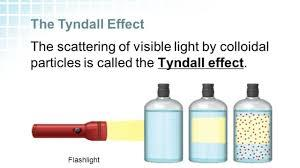
Explain Tyndall effect.
Answer
582.6k+ views
Hint: It is a property exhibited by the particles of a colloidal solution. Suspensions and true solutions do not show this phenomenon.
Complete step by step answer:
> Tyndall effect is the phenomenon in which light is scattered by the particles in a colloid. This property is also shown by some very fine suspensions. Thus, a given solution can be verified if it is a colloid or not. > It is also known as Willis-Tyndall scattering. The intensity of the scattered light is inversely proportional to wavelength raised to a power four. Hence, blue light is scattered much more than red light. Actually, in the Tyndall effect, the longer wavelengths are more transmitted whereas the shorter wavelengths are more reflected via scattering.
> When a beam of light is passed through a colloid, the colloidal particles present in the solution obstruct the path of the beam and allow the beam to partially pass through. The light collides with the particles of colloids and is deviated from its normal path, which is a straight line (scattered). This scattering of light makes the path of the light beam visible. Tyndall effect is observed when the diameter of an individual particle is of the range between 40 and 900 nm. Comparatively, the visible light spectrum ranges from 400 to 750 nm.
> The Tyndall effect was first discovered by John Tyndall in the 19th-century.

Note: Tyndall Effect Colloids are often confused with true homogeneous solutions because the individual dispersed particles of a colloid cannot be seen.
Complete step by step answer:
> Tyndall effect is the phenomenon in which light is scattered by the particles in a colloid. This property is also shown by some very fine suspensions. Thus, a given solution can be verified if it is a colloid or not. > It is also known as Willis-Tyndall scattering. The intensity of the scattered light is inversely proportional to wavelength raised to a power four. Hence, blue light is scattered much more than red light. Actually, in the Tyndall effect, the longer wavelengths are more transmitted whereas the shorter wavelengths are more reflected via scattering.
> When a beam of light is passed through a colloid, the colloidal particles present in the solution obstruct the path of the beam and allow the beam to partially pass through. The light collides with the particles of colloids and is deviated from its normal path, which is a straight line (scattered). This scattering of light makes the path of the light beam visible. Tyndall effect is observed when the diameter of an individual particle is of the range between 40 and 900 nm. Comparatively, the visible light spectrum ranges from 400 to 750 nm.
> The Tyndall effect was first discovered by John Tyndall in the 19th-century.

Note: Tyndall Effect Colloids are often confused with true homogeneous solutions because the individual dispersed particles of a colloid cannot be seen.
Recently Updated Pages
Master Class 12 Business Studies: Engaging Questions & Answers for Success

Master Class 12 Economics: Engaging Questions & Answers for Success

Master Class 12 English: Engaging Questions & Answers for Success

Master Class 12 Maths: Engaging Questions & Answers for Success

Master Class 12 Social Science: Engaging Questions & Answers for Success

Master Class 12 Chemistry: Engaging Questions & Answers for Success

Trending doubts
What are the major means of transport Explain each class 12 social science CBSE

Which are the Top 10 Largest Countries of the World?

Draw a labelled sketch of the human eye class 12 physics CBSE

Explain sex determination in humans with line diag class 12 biology CBSE

The pH of the pancreatic juice is A 64 B 86 C 120 D class 12 biology CBSE

Give 10 examples of unisexual and bisexual flowers




